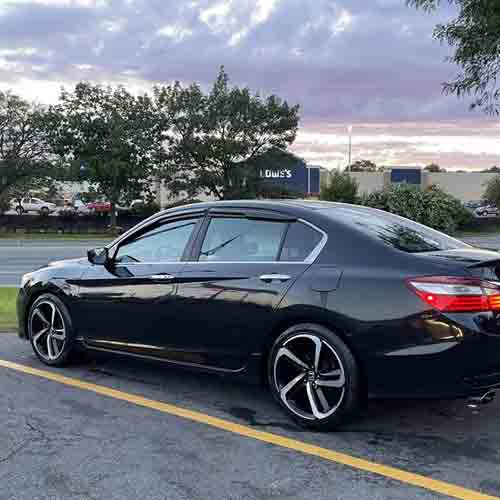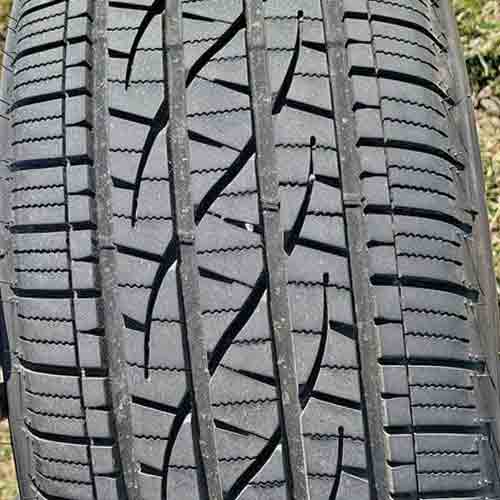Firestone Destination LE3 is a reliable tire for both daily commutes and long drives. It adapts well to different road conditions, offering you a steady and dependable performance. Let’s explore, what this tire has to offer for your journeys.

Table of Contents
Sizes Available
The Firestone Destination LE3 comes in 15 to 22 inches wheels. And all of those sizes have following specifications.
- Speed ratings: T, H and V (most sizes have H).
- Load ratings: SL and XL.
- Tread depth range: Almost all sizes have 10/32″.
- Weight range: 21 to 40 lbs.
- UTQG: 700 A B
- Winter ratings: No 3PMSF, only M+S.
- Tread mileage rating: 70k miles warranty.
Tread Pattern
The Firestone LE3 comes with a distinctive design, coming with a symmetric tread pattern.

Now interesting thing to note about its pattern is its S and F shaped lugs (giving off initials of Fire Stone).
Sure they look great, but they are made that way purposefully, where their lateral grooves offer superb wet traction capabilities.
These are only placed on the central lugs where 3 main ribs are seen.
All these central lugs are also equipped with V shaped notches, chamfered edges and full depth interlocking siping.
Moving towards the shoulders, these are comparatively more compacted up.
They although have similar interlocking siping, the extra attached rib has notches and make longitudinal slits with the shoulders as well.
Compare Destination LE3 With Others
- Firestone WeatherGrip
- General Grabber HTS60
- Firestone Destination LE2
- Bridgestone WeatherPeak
- Kumho Crugen HT51
- Cooper Endeavor Plus
- Michelin Defender 2
- Pirelli Scorpion AS Plus 3
- Bridgestone Alenza AS Ultra
Noise Generation
Tire noise often originates from the collision of air particles with the tire’s tread walls, primarily facilitated through the shoulder voids. Meaning most of the air comes in through the sides of the tread, hitting around and generating noise.
Now although most all season tires come with integrated connectors or ridges between the shoulder lugs, substantially reducing air penetration into the tread, the Firestone Destination LE3 does not offer this feature.
Though still the overall noise generation isn’t so bad after all, as there’s a very low white background noise, and some minimal impact noise with barely-noticeable tread vibrato.
So what makes it a nice quiet tire?
Well, one, the tire offers smaller tread depth, compared to its other HT peers, where its only 10/32″. So with this, there’s less area for the air to hit around.
And second, it offers much better (updated form its predecessor), variable pitch technology.
This tech minimizes in-groove resonance, effectively reducing the reverberation of sound waves, not allowing them to amplify. (This happens because diverse lug geometries alter the frequencies of (noise from) colliding air particles.
Highway Performance
When assessing the performance of a tire on dry highways, two things are wroth the discussion, the tire’s overall traction, and the steering response.
Dry Traction
The dry traction is again two parts, directional and lateral grip.
Directional grip mainly comes from the central lugs and is measured with braking distances, (as the central area of the tire basically offers the most rubber to road connectivity).
While the lateral traction depends on shoulders, as the cornering tire gets the most weight on its tread edges.
Now, the Firestone Le3 offers pretty commendable performance in both these aspects. I mean it’s not necessarily the best in its category, but its above average (only lacking slightly behind the most gripping Continental TerrainContact H/T, its direct competitor).
It’s superior braking efficacy comes from its intricately designed lateral grooves and chamfered edges on the central 3 ribs.
The voids act as in-groove notches, where their slanted lateral directions provide the needed efficacy for the tire to brake and accelerate (aka directional grip).
Similarly with the combination of biters on shoulders, where you can observe interlocking sipes, and lateral notches provide the needed lateral traction.
Steering Feedback
Now traction is only half of the equation, as you don’t see the full picture without the steering feedback.
And let me tell you, this tire offers a very natural tone with its steering (on track), where its pretty communicative, and you don’t see any surprises, unless of course one severely pushes it beyond its limits, but even that leads to manageable, understeer (even though its significant).
And this has to do with the tire’s well balanced construction of rigidity and flexibility.
I mean it’s tread is one of the most pliant you’d find (in its tire category of Highway All-Season), while its relatively smaller tread depth (only 10/32″ being HT), combined with stiffer nylon cap ply gets you right in the middle.
Meaning you get a nice balanced over and understeer, which is very communicative and controllable.
Basically in essence, having extra flexibility gets the tire susceptible to understeer, while the rigidity does the opposite.
Though keep one thing in mind that the tire can still benefit from enhanced accuracy, especially on-center.
Wet Traction
The predecessor of the Firestone Destination LE3 unfortunately gained a very negative popularity in terms of it’s wet grip, and that was mainly because of 2 things.
One the tire didn’t have full depth sipes, and two, it’s was prone to wearing off faster.
Let me explain how the newer tire fixed that by dividing this section in to two parts. (Though you can check the comparison of both, LE3 vs LE2 here).
Wet Grip
Sipes are the small cuts or slits in a tire’s tread that hold air, and as the tire rolls over the road, these sipes get pressurized (meeting with the ground), and they release that air, creating a suction effect, which helps the tire absorb more water.
So this tells us that, more sipes would mean superior grip, and that, those sipes need to be pliant (otherwise they won’t flex to create the needed suction).
Now the Destination LE3 features full depth interlocking sipes throughout its tread, with a combination of thick lateral slits and in-groove notches (working at multiple angles, due to their curved design).
These effectively soak up the water particles (from all angles), so the tire’s rubber could properly grip on the relatively dried up surface.
Moreover, the tire also does better in the hydroplaning department, and that also positively affects the overall wet traction (see below).
Hydroplaning
So hydro or aquaplaning happens when the tire can’t get rid of water properly and starts to “float” on a thin layer of water, losing grip.
So here grooves help by evacuating water out in time.
But how does it help with the tire’s traction? Well, because more water escaped through grooves mean less water is there for sipes to deal with.
That’s why the Firestone Destination LE3 with a combination of proficient interconnected lateral and longitudinal tread voids doesn’t face this problem.
Especially its lateral grooves, which carry the Firestone’s Hydro-Grip technology allow this tire to have above average straight and curved aqua float speeds.
On-Road Vibrations
Attaining optimal absorption of road inconsistencies is crucial for achieving a ride experience that is both comfortable and smooth.
In this aspect, the Firestone Destination LE3 could benefit from some refinements.
While its rubber compound may not excel at smoothing out all the larger bumps and changes in the road (as its other all-season competitors), the tire maintains notable stability and control when traversing smooth pavements.
Side Note: One of this tire’s direct competitor, the Kumho Crugen HT51 (review) offers much better overall comfort performance, just an FYI.
Tread Wear
The lifespan of tire tread is influenced by a multitude of factors. These include:
- The inherent weight of the tire.
- Its propensity for rolling resistance.
- And its specific composition of the rubber.
And considering all of these, the Firestone Destination LE3 does a good enough job here, allowing it to confidently have 70k miles warranty.
Even though the tire only offer 10/32″ of tread depth, its stiffer rubber compound is still not susceptible to faster wear rate.
Sure shallower tread depth usually means less time to reach down to 2/32″ replacement depth levels, but it also means that the lugs would not flex too much. And because of this the tire does not generate too much heat, which is also a factor negatively affecting tread life.
FYI: If tread life is your priority, then you should definitely check out the Goodyear Assurance MaxLife (review).
Winter Traction
All-season tires are renowned for their excellent performance on snowy terrains, where they show up with above average handling, braking, acceleration and overall traction capabilities.
But comparing the Firestone Destination LE3 with its direct competitors reveals some points which can’t be ignored.
For example, the tire has 2 main weak points (on snowy tracks).
One, it needs a little more acceleration efficacy compared to its counterparts. And two, its steering isn’t assertive enough, I mean when you look at its overall decent gripping values.
This has to do with the tire’s relatively stiffer rubber compound, which although offers decent tread life and above average steering on dry, it tends to get harder with freezing winter temperatures.
So it’s biters aren’t able to properly flex and provide you with the needed grip.
So it makes sense why it doesn’t come with the 3 peak mountain snowflake rating.
Fuel Consumption
Fuel consumption is largely dictated by rolling resistance, a factor greatly influenced by the tire’s construction, (where tread design, composition and weight are considered).
Now let me tell you that the Destination LE3 offers a pretty decent job here.
Given its tread depth of only 10/32″ (in contrast to most competitors which offer up to 14/32″), and featuring a harder tread, the lugs of this tire experience minimal flexing during maneuvers.
And yes with shallower tread depth you also get one of the lightest structure (comparatively), so there’s reduced pressure on the lugs, which also prevents them to bend excessively, conserving fuel energy.
This careful balance of design elements not only preserves the integrity of the tire but also contributes to its overall fuel efficiency, offering a blend of durability and economy.
To Conclude
The Firestone Destination LE3 offers a comprehensive performance profile, where there are both pros and cons.
It exhibits commendable dry traction and braking efficacy, with its well designed grooves and edges, providing reliable and balanced steering feedback, (where it needs a little improvement in handling).
And in wet conditions, the tire demonstrates significant improvement from its predecessor, with full-depth interlocking sipes.
Though its snow grip is not as impressive.
Furthermore, the tire’s overall noise generation is relatively low, yet, its ride quality could benefit from further refinements.
And as for fuel and tread life, both are commendable, thanks to the tire’s low rolling resistance generation.
You Sir are a PRO! Period!
Well done.